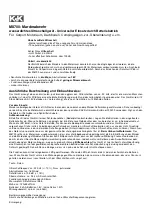
Glossary
103
RNS
®
System User Manual
ECoG storage trigger.
The type of neurostimulator activity selected by the user to result in the storage of
an ECoG record if the activity occurs.
Elective replacement indicator (ERI).
The ERI indicator is displayed on the programmer to notify the
user that the neurostimulator is approximately three months prior to end-of-service (EOS).
Neurostimulator elective replacement is suggested at a battery voltage equal to the ERI.
End-of-service (EOS).
End of service is the point in service at which the battery level is still sufficient to
allow operation, however some features may be lost.
Episode duration.
The time elapsing between the point at which the neurostimulator detects Pattern A or
Pattern B to the point at which post-episode baseline activity is detected.
Event.
Activity detected by the neurostimulator. Events are considered any of the following: long
episodes, pattern A, pattern B, responsive therapy, noise or saturation.
Ferrule.
The ferrule is intended to be installed in a craniectomy to secure and mechanically support the
neurostimulator in the cranium.
Ferrule Clamp.
The ferrule clamp is used to secure the neurostimulator to the ferrule.
First pulse delay.
A programmed delay in the delivery of the first pulse of a burst, measured from the
time of synchronizing to a signal peak.
First pulse synchronization.
Delivering the first pulse in a burst or after a first pulse delay (synchronous)
from a peak in an ECoG signal.
Fixed pulse interval.
The fixed pulse interval is a setting available for each responsive therapy burst.
Fixed pulse intervals are delivered at the same frequency each time a therapy is delivered.
Frequency.
The frequency is the rate at which pulses are delivered which is expressed in Hz
(pulses/second).
Impedance measurement.
The opposition of current flow between electrodes as determined by
measuring the voltage (Ohms) resulting from the delivery of a current pulse. A current pulse must be
applied to the patient in order to obtain this measurement.
Implant configuration.
Information which describes the port(s) to which the proximal end of the lead(s)
are connected.
Interactive Session
.
A programming session that follows interrogation of the neurostimulator.
Interrogate.
The act of retrieving stored data and settings from the neurostimulator using the
programmer.
Lead Cap.
The lead cap is intended to physically protect the proximal ends of implanted leads that are
not connected to the neurostimulator.
Lead label.
Numerical and/or alpha characters assigned to a lead to describe its anatomical location.
Lead Strain Relief.
The lead strain relief is intended to mechanically support the proximal ends of the
lead at their exit point from the neurostimulator.
Line length detection tool.
The line length detection tool performs an estimate of the length dimension
of a signal related to the complexity of a signal.
Long episode.
Initiate ECoG storage when a detected episode continues beyond a preset duration.
Magnet.
The magnet suppresses RNS
®
System therapy as long as the magnet is in position. Placing the
magnet over the neurostimulator also triggers a diagnostic, and can also be programmed to trigger ECoG
storage.
Measurements.
Programmer display of measurements of the neurostimulator lead impedances, battery
voltage, and charge time.








































